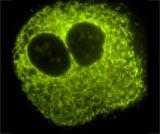
The ghostly image above shows a subdividing cell treated with a fluorescent stain that is selectively absorbed by mitochondria.
As part of a national effort to identify biomarkers for early detection of cancer, NIST is developing safer, faster, and more efficient methods for sequencing the DNA from mitochondria, the tiny energy factories of cells.
Mutations within the DNA of mitochondria—a circular strand containing more than 16,000 nucleotide base pairs—have been implicated in a variety of cancers. In one small study by Johns Hopkins University, for example, such mutations were found in lung cancer cells but not the normal cells of the same patients. NIST researchers are working to validate the mitochondrial DNA sequence measurement technology and increase the speed of the sequencing protocol. They hope that this will lead to improved methods that could be used in clinical applications.
A major advance involves the use of a state-of-the-art robotics workstation to automate what is usually a manual process for sequencing mitochondrial DNA—determining the exact order that the DNA's four component chemicals are linked together within the strand. The team is also using fluorescent tags for the analysis, a safety advantage over the typical radioactive materials.
The researchers' goal is to obtain entire sequences from as little as about 200 nanograms of DNA, about 10 times less volume than other labs use. Once the overall process is perfected, NIST scientists will use it to sequence mitochondrial DNA collected by Johns Hopkins from 200 people, some with lung cancer and some without. Any systematic differences between the two group's results could potentially serve as a biomarker for lung cancer.
NIST's primary role in the National Cancer Institute's Early Detection Research Network is to validate findings, standardize methods, and advise other research and clinical institutions on technology. In the mitochondria project, NIST researchers are developing a standard process so that validated biomarkers can be used reliably by other laboratories to detect cancer in asymptomatic patients, make a diagnosis once symptoms appear, or monitor cancer patients for recurrence or individuals known to be at high risk.

